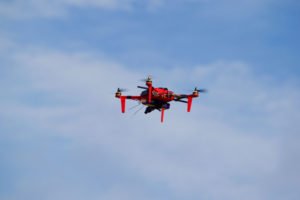The enterprise drone industry is growing – but it’s still at the beginning stages. For enterprises starting the process of building a fleet, the complications are many – but so are the benefits.
The following is a guest post by Diana Manning, systems engineer and advisor at Base2 Solutions, a top engineering consultancy. DRONELIFE neither receives payment nor pays for guest posts, which are chosen based on their value to our readers.
The growth of drones has far outpaced all expectations, exceeding the projections forecasted by the FAA in 2018 by over 80 percent – and the trend is expected to continue. By 2023, estimates point to more the 835,000 aircraft (consumer and professional) taking up airspace. Drones are an appealing solution for companies across a wide breadth of industries with their relatively inexpensive start-up cost and variety of useful applications. However, while the initial investment may be minimal, there are still many gray areas yet to be uncovered that could lead to increased costs, regulation and management issues for any corporation looking to own their own fleet. What are these potential pitfalls and how can corporations make a solid decision on whether or not to take to the skies? The answer varies greatly depending on the size of the fleet and the type of information transmitted or collected.
Outside of players like UPS, Skyward, Amazon and Google who are hoping to launch large-scale fleet operations for package deliveries, most drone implementations are smaller, typically consisting of just a few vehicles. Surveys show that drones are already being utilized successfully in a variety of trades beyond the aspirational delivery model. Top uses for drones are in the research and development space, the film/entertainment/sporting vertical and the industrial/utility/environmental arena.
Corporations recognize that starting small is the best way to understand some of the complex operational issues before making a move to a more significant commitment. While the drone industry is still in its infancy, here are a few key areas to consider before moving forward.
Government Regulation
There remains a lot of gray area in regard to how the FAA will license and certify drone operations. What is now a fairly inexpensive barrier to entry may soon become much more cost prohibitive as the FAA explores the training and certifications necessary to operate drones safely. Based on how it manages traditional aircraft, companies should be prepared to meet a substantial burden of proof that their drones do not pose a risk to human life, even in extreme scenarios which can include other airborne traffic and inclement weather conditions.
Current regulations limit the size of drones to 55lbs or less, and mandate daylight-only operations with a ceiling of 500 feet over unpopulated areas. They also require a pilot for each drone with a line of sight to the vehicle. Remote pilot certifications are required for commercial use. As the FAA’s regulatory framework evolves and is written into law, companies will need to assess whether the operational requirements are worth the benefits. Beyond the FAA, companies should expect regulations from other agencies, including OSHA, NASA and the FCC.
Security and Privacy
As with all connected devices, drones send and receive data on an ongoing basis. Companies will need to consider how they will store and manage the data collected by these drones, which could often be proprietary and should be protected. Safety also becomes a huge concern as any connected device presents an attackable surface for hackers, not to mention hijackers. Companies will have to build hardened control and operations systems and constantly update their software to make sure they’re completely protected at all times.
In addition to operational safety and protections, many commercial off-the-shelf drones are manufactured by foreign companies, which could create both security and political issues.
Infrastructure
Aside from the data storage and protection issues mentioned above, companies will also need to develop infrastructure to ensure that their drone fleet can achieve both the scale and the profitability needed to make the operation worthwhile.
For larger fleets, it could be cost prohibitive to have a pilot for each and every vehicle, which means an investment in some type of system to manage and control autonomous flight operations. Complex traffic control and other operational requirements might mean companies have to invest in AI or machine learning systems. While this would mean that the drones would “learn” each time they fly and could potentially streamline future trips, the relative newness of such systems could lead to a lengthy implementation process and require heavy investment in terms of technology and personnel.
For some applications, advanced analytics technology will be required to derive value from the massive amount of information and data drones can collect. Analysis could range from information collected while in-flight but may also extend to analyzing the drone itself to improve future flights, streamline routes and predict future failures.
Exciting Prospect for the Future
The potential for drones is massive and the excitement around their current and upcoming capabilities is justified. They can reach new places and perform tasks that are too difficult, time consuming or dangerous for humans to perform. They provide new ways to gather and use data for a wide range of commercial, agricultural and industrial tasks and offer a flexible, rapidly deployable solution for public safety and disaster response. While the possibilities are endless and the applications far-reaching, the technology, regulation and management of drones is still very much in the beginning stages of development. Companies should take a metered approach to the incorporation of drones into their ecosystem and balance the promise with the realities of the business, technical and regulatory challenges they pose.
 Diana Manning is a systems engineer and technical program manager with a broad array of experiences in airplane development programs, complex aircraft engine/ propulsion systems integration, and team leadership. Diana’s experiences cover all phases of the propulsion life cycle; from concept feasibility analysis, definition/development to powerplant integration, engine/laboratory and flight test, build and fleet support.
Diana Manning is a systems engineer and technical program manager with a broad array of experiences in airplane development programs, complex aircraft engine/ propulsion systems integration, and team leadership. Diana’s experiences cover all phases of the propulsion life cycle; from concept feasibility analysis, definition/development to powerplant integration, engine/laboratory and flight test, build and fleet support.
Diana has nearly 35 years of professional experience in aero-engineering integration, propulsion and aircraft systems. Today, Diana utilizes her many years of aircraft experience as a systems engineer and advisor for Base2 Solutions. Within this role, Diana is able to leverage her systems experience both in aerospace and expand that knowledge for use in other industry applications.
Miriam McNabb is the Editor-in-Chief of DRONELIFE and CEO of JobForDrones, a professional drone services marketplace, and a fascinated observer of the emerging drone industry and the regulatory environment for drones. Miriam has a degree from the University of Chicago and over 20 years of experience in high tech sales and marketing for new technologies.
For drone industry consulting or writing, Email Miriam or (for paid consulting engagements only) request a meeting through AdvisoryCloud:
TWITTER:@spaldingbarker
Subscribe to DroneLife here.
https://dronelife.com/2020/02/20/building-the-drone-fleet-top-engineering-consultant-talks-complications-and-approaches-for-the-enterprise/
 Unmanned Aerial Vehicle The latest drone news
Unmanned Aerial Vehicle The latest drone news






